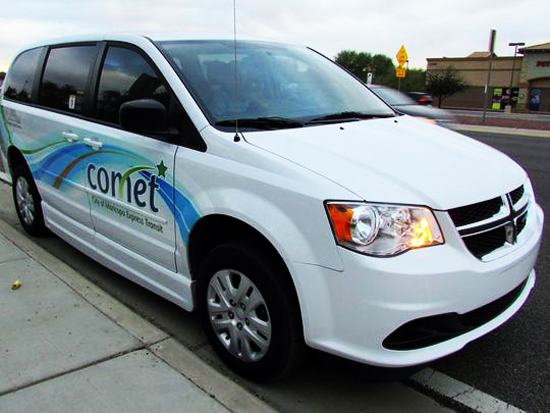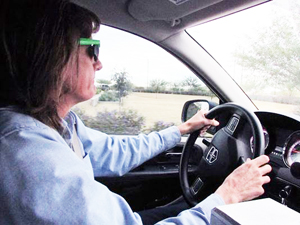 By Jenny Ung | Cronkite News
By Jenny Ung | Cronkite News
If Kelley Dalton, one of the two drivers for the city of Maricopa’s public transportation system, doesn’t see passengers waiting at the designated, but unmarked, bus stop, she drives on to the next.
There are no bus stop signs, no signal that tells the residents of Maricopa that a public transit van is around the corner. Known as the Comet, some days, nobody rides the white van at all.
“There are some days I drive around by myself all day,” Dalton said. “It happens.”
In rural areas like Maricopa, the Federal Transit Administration through a grant called Section 5311 funds public transportation systems like the Comet. Arizona received more than $11 million for rural areas in the 2015 fiscal year.
Maricopa operates a fixed route service, a circulating bus that runs between fixed points throughout the city (which Dalton drives) and a demand response service, which picks people up from their homes and takes them to their destination if they make reservations 24 hours in advance. A regional shuttle that also requires a 24-hour advance reservation takes passengers to Chandler and Casa Grande.
But despite the access to funding, the lack of outreach for the transportation brings a low ridership to the Comet’s fixed route in a rural area where many need the service to get to jobs, doctor’s appointments and grocery stores.
Dalton blames the low ridership on the lack of advertisement.
“In order to find my bus on the Internet, you have to go to the website, you have to click on transportation, you have to type in Comet,” she said. “Who’s going to do that? No one’s going to do that. I think if this bus had its own website, people would see that and Google it, and we’d have more passengers.”
She’s suggested this to her superiors before, but nothing’s come out of it, she said.
“Word-of-mouth just isn’t enough,” she said.

David Maestas, Maricopa’s transportation/transit planner, said the fixed route, was introduced a few months ago and is in the process of building ridership.
Who rides the Comet
Before adding new routes, city officials need to assess whether there is enough demand to support them, he said
“We have what has been historically a concierge of very loyal riders, and a lot of those are seniors,” he said. “But as we go along we hope to pick up new target markets.”
For example, the city would like to work with Central Arizona College’s Maricopa campus to create a separate route that would pick up students at residential neighborhoods and transport them to the college, Maestas said.
The system will grow slowly in order to “ensure sustainability, a cardinal rule in transit planning,” Maestas said. “We believe that the demand here is based on the population of about 50,000, but we want to be careful not to overgrow it and put it in danger of failing.
Bonita Crit, one of Dalton’s passengers, only knew about the bus because her daughter is the other Comet driver. Crit has used the Comet three times a week since July, when she came to Arizona from San Diego to visit her grandchildren.
She uses the Comet to get home from the dialysis center.
“I really appreciate (the Comet) because before when I was here, there would be no transportation in Maricopa,” Crit said. “Unless you can get a ride, or a cab, or a shuttle.”
“But if you call a cab, it’s going to come from town and it’s going to charge you a lot of money,” Dalton added from her driver’s seat.
There are medical transit shuttles in the area as well, but they are not part of the public transportation system.
“Those are expensive, aren’t they, Bo? (Bonita)” Dalton asked.
“Oh yeah, I’ve had my share of that,” Crit said.
Why does Maricopa need public transportation
The grant from Section 5311, or the Formula Grants for Rural Areas Program, is supposed to help address the transportation needs of Arizona’s rural population.
“Funding has been adequate for our needs. But we’re very careful not to grow too far based on our demands. Our strategy is to grow the service slowly and steadily to make sure we can sustain it,” Maestas said. “It’s pretty well known in the transit industry that if you get too far with it, and you go too fast, sometimes you get in danger of the system failing.”
Before public transit came to Maricopa, “everybody had to fend for themselves,” he added.
“While this was particularly hard on the underprivileged population, it was harder on the elderly because sometimes they might be confined to their homes due to physical disability or their age,” Maestas said.
“They had to rely on family members or commercial transportation. In the case of the underprivileged population, they just couldn’t afford a vehicle — they were basically just left to fend for themselves,” he added.
Maricopa is one of 21 cities currently participating in the program, which ranges from small rural communities to more urbanized areas.
Every weekday, Dalton drives her fixed route in two-hour blocks — one in the morning, from 7 to 9 a.m., and one in the afternoon, from 3 to 5 p.m. She considers five passengers a good day.
Maricopa, with a population of nearly 50,000, has changed since she first moved here more than 15 years ago. Back then, she said, there was a row of pecan trees along a road with barely any housing developments and a main road made out of dirt. Now, houses and neighborhoods rest in the central part of the town and roads are paved with asphalt.
Dalton moved from Phoenix to Maricopa in 1999 mainly because land was cheap. She was able to buy three acres of land for $7,000.
“There was nothing here (in 1999) though,” she said. “None of these houses were here, it was all agriculture. There was no grocery store, no Walmart, none of it.”
She would have to drive to Casa Grande or Chandler to buy groceries.
Before working as a Comet bus driver, Dalton was a school bus driver. Now, she is paid $14.50 an hour and works full-time. Charging only 50 cents per boarding and driving over 100 miles per day, Dalton said it is unlikely the transportation system is making money.
The 50 cents Crit pays for her ride back home from dialysis is put into a silver metal fare box. Crit uses a wheelchair, so when Dalton drops her off in the parking lot across from Central Arizona College, she brings down the wheelchair ramp. It takes the combined strength of Dalton and Crit’s daughter to slide her into the wheelchair.
“I do what I can to help them out,” Dalton said. “We have a lot of elderly people like that, that we take care of.”
Though Dalton is late picking the next passenger up at the Basha’s stop, Cassandra Woods still is waiting.
“That’s good, because she’s got heart problems,” Dalton said.
After getting out of work from the Bead and Berry Coffee House, Woods would otherwise have to walk the several miles home. She said she uses the Comet three to four times a week.
“There aren’t enough stops, enough times,” Woods said. “If you want to do anything between the times, you’re stranded.”











